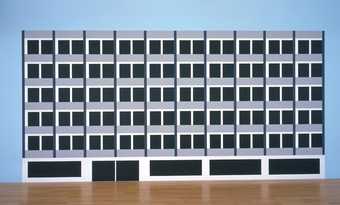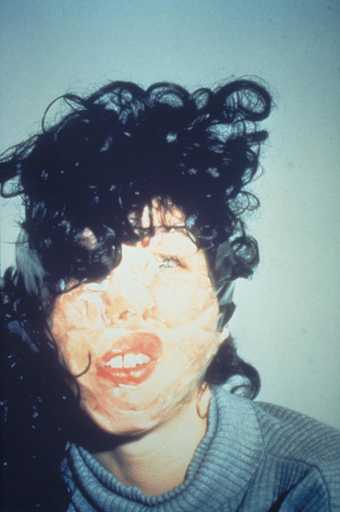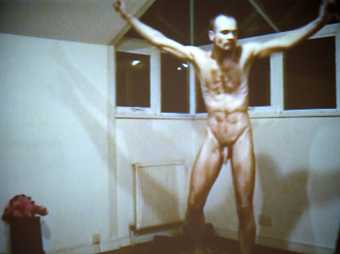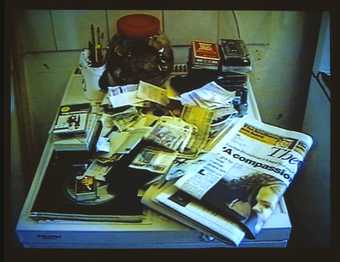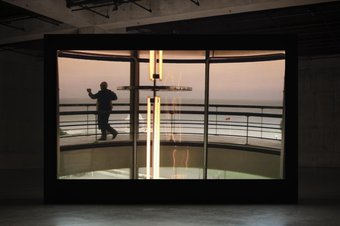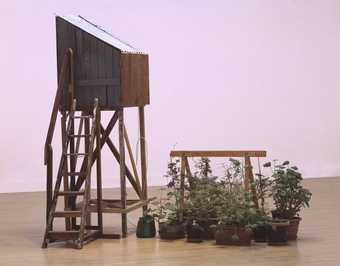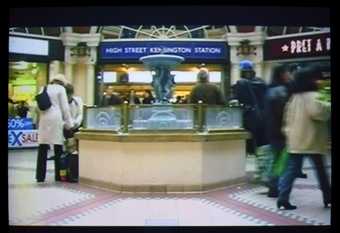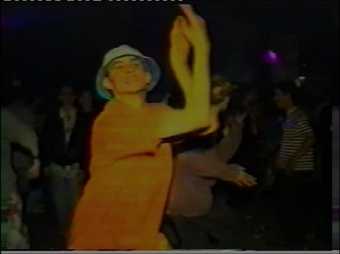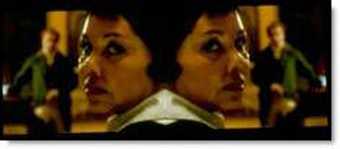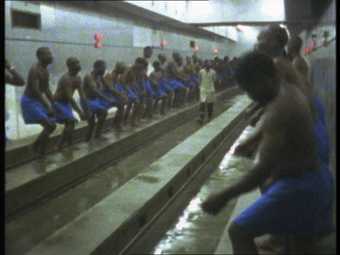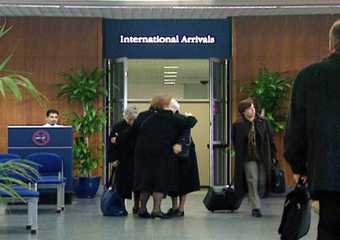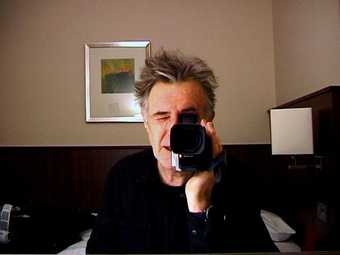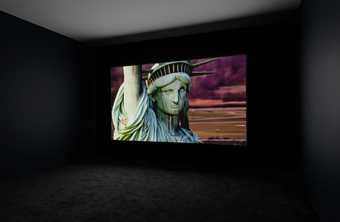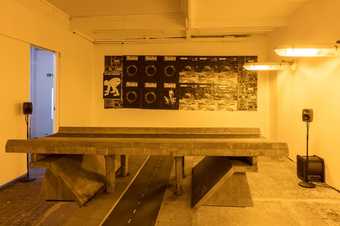On loan
Musée des Beaux-Arts de Rennes (Rennes, France): Jeremy Deller
- Artist
- Jeremy Deller born 1966
- Medium
- Wall painting, paint on fibreboard, vinyl text, map, books, jacket, shield, printed papers, 2 videos and audio.
video, projection, colour and sound - Dimensions
- Overall display dimensions variable
duration: 62min - Collection
- Tate
- Acquisition
- Commissioned and produced by Artangel, film directed by Mike Figgis. Presented by Tate Members 2005. The Artangel Collection at Tate
- Reference
- T12185
Summary
The Battle of Orgreave Archive (An Injury to One is an Injury to All) is an installation comprising texts, documents, objects, videos and other archival material, which provide a context for examining the intertwined narratives of two events: the 1984 strike by the National Union of Mineworkers (in particular the specific confrontation between striking miners and the police that occurred at the Orgreave Coking Plant in Yorkshire on 18 June 1984), and Jeremy Deller’s 2001 re-enactment of the same conflict, which the artist called The Battle of Orgreave. Split between two rooms, the installation presents its constituent materials in a way that blurs the boundaries between their status as objective documents on the one hand, and historical relics on the other.
The walls of the first room contain a timeline that recounts the strike and the specific events at Orgreave and their aftermath. This is supplemented by items such as a denim jacket studded with union enamel badges, a police riot shield, original newspapers reporting the unfolding events, and a framed photograph of graffiti on a brick wall celebrating the union leader Arthur Scargill: ‘Scargill No.1’. Adjacent to the timeline, a wall painting in black paint depicts an image of a bare-chested striker being arrested by four policemen in riot gear. On this wall is mounted a shelf with a wide range of books related to the strike, from specific accounts of the events to the memoirs of the industrialist and director of the National Coal Board Ian MacGregor, the Prime Minister Margaret Thatcher, and the MI5 chief Stella Rimmington, and the diaries of Labour politician Tony Benn. Alongside this is a small video monitor that plays a recording of the ‘World in Action’ television programme covering the original events at Orgreave. A wall vinyl image shows a red map of Britain with handwritten names of places that feature in the timeline, and to one side of this is another small video monitor that plays a film entitled Police Riot Training, accompanied by a framed text on police training. Three freestanding display cases in the room contain research material and documents from the 2001 reconstruction; these are accompanied by explanatory captions handwritten by Deller (as do the riot shield and denim jacket). The second room contains Mike Figgis’s documentary film of the re-enactment, which weaves together interviews with participants with footage of the event.
Deller’s title for the installation directly underlines the message of the work. The slogan ‘an injury to one is an injury to all’ was popularised by the international organisation, the Industrial Workers of the World, or Wobblies, and was widely adopted by union organisations because of its direct humanist appeal for solidarity. This slogan also echoes one of the popular chants of the striking mineworkers: ‘The miners united will never be defeated!’ For Deller the miners’ strike, and specifically the clash between the pickets and police at Orgreave, resembled the events of a civil war, medieval in their physical and social brutality. In 1994, as part of a series of posters that appeared to advertise exhibitions in art galleries of pop-cultural events or figures (for example an ‘Acid House’ exhibition at Tate Liverpool, and a Keith Moon retrospective at the Tate Gallery), Deller produced a poster, printed as if on a fake piece of parchment, announcing the Sealed Knot’s re-enactment of ‘the bloody battle of Orgreave’ under the title The English Civil War (part 2). Seven years later that aspiration became a reality through the support of the commissioning and production agency Artangel. Deller has explained how the memory of seeing the original news reports as an eighteen-year-old affected him and led him later to engage with the social divisions created by the events surrounding the miners’ strike:
The image ... stuck in my mind and for years I wanted to find out what exactly happened on that day with a view to re-enacting or commemorating it in some way. It would not be an exaggeration to say that the strike, like a civil war, had a traumatically divisive effect at all levels of life in the UK. Families were torn apart because of divided loyalties, the union movement was split on its willingness to support the National Union of Mineworkers, the print media especially contributed to the polarization of the arguments to the point where there appeared to be little space for a middle ground. So in all but name it became an ideological and industrial battle between the two sections of British society. (Deller 2002, p.7.)
For Deller, the specific historical event that unfolded at Orgreave stands as a symbol of the destruction of mining communities as well as the wider social fabric of the working class during the Thatcher government. Orgreave was already identified by Deller in this respect in his 1997 work History of the World (Tate T12868 and P78412), a work of social and community cartography that accompanied his Acid Brass project for which colliery brass bands played arrangements of acid house music. In History of the World, brass bands signal ‘Civic Pride’ and ‘Melancholy’ as well as ‘Deindustrialisation’ and ‘The Miners Strike’, from which arrows point directly to the words ‘Orgreave’ and ‘Civil Unrest’.
The 2001 reconstruction took place in Orgreave on 17 June, and its cast and expertise was drawn from more than twenty historical re-enactment societies under the direction of the re-enactment tactician Howard Giles, along with veterans of the original conflict drawn from both sides of the battle lines. However, while re-enactments usually serve to investigate what might have happened, or to offer a re-interpretation, even a corrective, to history, Deller’s intention was, as the curator Ralph Rugoff explains, ‘to openly acknowledge that any history is inevitably impure, highly mediated, and in need of being re-written’ (Deller 2012, p.17). This openness, identified by historian Stuart Hall as Deller’s ‘political imaginary’ (Deller 2012, pp.81–9), characterises the way in which different orders of material – those that reflect on the original historical event or the re-enactment – are brought to bear in the installation, and the differences between artifice, documentary realism and fact are challenged. Similarly, Deller’s use of re-enactment societies and his subversion of their usual relationship to history are an important aspect of the subject and meaning of The Battle of Orgreave Archive (An Injury to One is an Injury to All). For this work, as with most of his projects, Deller interacted and engaged with different social groups or communities to produce an artwork that can take many forms. Some of his other projects have been realised in the form of an exhibition, a march, a book, an installation, a discussion, a road trip or a convention. Instead of making objects, Deller is an artist who curates or facilitates the unfolding of situations between groups of people.
Further reading
Jeremy Deller, Jeremy Deller: Life is to Blame for Everything. Collected Work and Projects 1992–99, London 2001.
Jeremy Deller, The English Civil War / Part II, London 2002.
Jeremy Deller, Joy in People, exhibition catalogue, Hayward Gallery, London 2012.
Andrew Wilson
October 2012
Does this text contain inaccurate information or language that you feel we should improve or change? We would like to hear from you.
Film and audio
Explore
- abstraction(8,615)
-
- non-representational(6,161)
-
- text(1,043)
- clothing and personal items(5,879)
- painting(473)
- book - non-specific(1,954)
- newspaper, ‘Guardian, The’(13)
- newspaper, ‘Sunday Mirror’(2)
- newspaper, ‘Sunday Times’(14)
- poster(874)
- actions: expressive(2,622)
-
- fighting(137)
- man(10,453)
- UK cities, towns and villages(12,725)
-
- Orgreave(1)
- England(19,202)
- England, Northern(2,975)
- crime and punishment(436)
-
- arrest(33)
- unemployment(10)
- civil rights(183)
- crime and punishment(431)
-
- policeman / woman(102)
- miner(128)
You might like
-
Alan Green One to Four
1982 -
Julian Opie You pass an office building. 3
1996 -
Gillian Wearing CBE Confess All On Video. Don’t Worry You Will Be in Disguise. Intrigued? Call Gillian Version II
1994 -
Sam Taylor-Johnson OBE Brontosaurus
1995 -
Tracey Emin Tracey Emin C.V. Cunt Vernacular
1997 -
Ian Breakwell The Other Side
2002 -
Tracey Emin The Perfect Place to Grow
2001 -
Oliver Payne, Nick Relph The Essential Selection
2002 -
Mark Leckey Fiorucci Made Me Hardcore
1999 -
Sir Isaac Julien CBE RA Vagabondia
2000 -
Sir Steve McQueen Caribs’ Leap/Western Deep
2002 -
Mark Wallinger Threshold to the Kingdom
2000 -
John Smith Hotel Diaries
2001–7 -
Sir Steve McQueen Static
2009 -
Mark Leckey Affect Bridge Age Regression
2017–19



